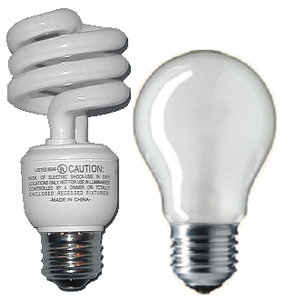 Image via Wikipedia
Image via Wikipedia
Let me give an example of where a major web store did not do the research. Seems Amazon UK now has a store for lighting, to buy lightbulbs and all. Why would anyone want to do that when there's a supermarket or hardware store or small grocer on every corner here? Might it be that users will turn to web mail-order for lighting products not sold in shops?
What are these product then? Supermarkets carry energy efficient bulbs, but mostly only the cheapest ones available, which give an awful green hue to skin. I know people, including me, want better choices; I once changed the whole character of a bathroom from scary clinical to lovely just by replacing the fluorescent tube bulb the builder had used, which was, of course, the cheapest and coldest hue available, to a warmer hued one. Cost almost nothing. Impact was instant and big.
So what do I want to know when I mail order a light bulb? What kind of light it gives. There are actual standards for that, that allow consumers to make an informed choice, they are Color Temperature (is the white light warmer or colder) and the Color Rendering Index (how do colors illuminated by that light look compared to sunlight). While the indices are still subject to debate and change by lighting afficionados, light bulb manufacturers know these values for every bulb; these are very specific characteristics that they try to get just right so they have lighting for every environment and occasion available to designers. Lighting manufacturers produce stacks of brochures to warn and educate users about the variety of hues of lamps.
Now I am trying to find an energy saving light bulb of a specific size to fit a specific lamp that I would like to have not throw some ugly green-tinged light. And Amazon UK will happily try to sell me one, with prices ranging from £1.50 up to £50 (the latter is for LED bulbs that will last 20 years). Try to sell me one, that is, without telling me with plain, known, manufacturer-calibrated numbers, what kind of light it gives off. It's like trying to sell me clothes without even telling me the size or color. Sure, when you get the shirt you ordered home sometimes the green is sage to you and not verdigris like the page said, and XL is quite the variable these days, but at least those basic descriptions of an item were on the page. The CT and CRI values for bulbs are actually far better measured than clothing manufacturers name their colors.
It's bad enough I can't filter by fitting type, or indeed filter by these color values. But not even telling me at all, and leaving this up to the sellers to put in the text description, most of which, of course, call everything 'warm white'? Somebody here did not consider what users would want to use their actual site for.
